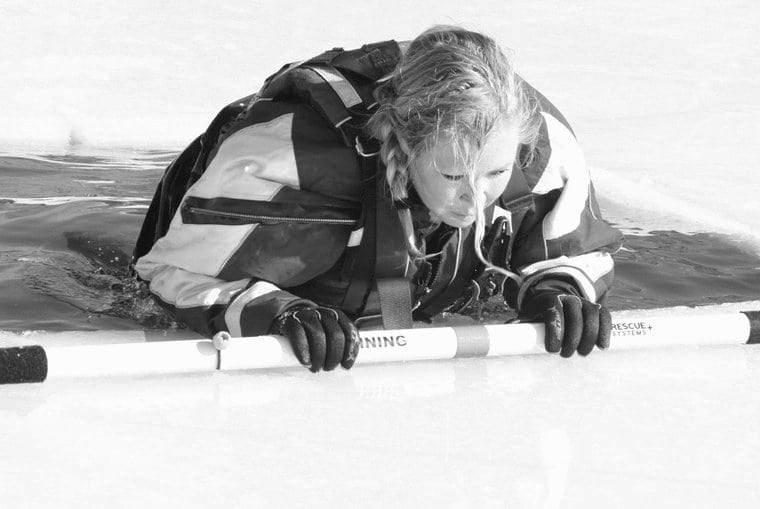Considerations for women participating in ice rescue as either a technician or as an accidental victim in an actual ice rescue or rescue scenario. No one has to tell you that on the average women feel the effects of cold temperatures sooner and at a much faster rate than men do. In the same room a man will feel comfortable and a woman will feel cold. There are many obvious and not so obvious contributing factors, Perception of temperature, Metabolism, muscle mass, fat distribution, smaller size, and internal functions to name a few. Women’s bodies produce less heat than a man’s body. Women on average are smaller than men with less muscle and more fat. Men naturally have more muscle, which equals a higher metabolic rate; more muscle equals more heat. The fact that the metabolism of most men is higher and faster than that of most women; also contributes to the idea that women tend to be and feel a lot colder than men.
Our metabolism is the way our bodies burn calories for fuel; our metabolic rate in turn heats our body. Women with a less muscle to fat ratio are burning less fuel, it only stands to reason that they would not be as warm as most men. Studies have shown that on the average and in general women have a higher internal temperature than most men. They also have a higher percentage of fat just under the surface of their skin. While fat does conserve heat, it traps it at the core, below the skin, meaning you’ll still feel cold when your skin cools down, even if your core temperature is still warm.
Women vasoconstrict at a much faster rate than men in cold temperatures. This vasoconstriction shunts the body’s blood to the core to keep vital organs warm, thus making the skin and extremities feel colder. Once the body’s blood is directed below the skin’s surface and beneath the subcutaneous fat layer women begin to feel the effects of the cold. Women’s hands and feet are cooler than a man’s to begin with sometimes up to 3 degrees cooler. This temperature differential puts women at a disadvantage right from the start. Their hands and feet are the first to get even colder, which makes them susceptible to frost nip or frost bite.
On average a man will last a lot longer in the same temperature before he perceives the effects of the cold on his hands and feet. With that said, even though a woman’s body in an icy water situation may be internally warm and she may not be in a stage of severe hypothermia, yet she most likely has lost feeling and dexterity in her hands, arms, feet and legs which will make it potentially impossible to self extricate or to even hold onto the ice shelf till help arrives. As an ice rescue technician staying warm is a must and proper protective equipment and gear is imperative; you need to be able to maintain dexterity to help not only rescue yourself but the people or pets you are going out to rescue.
It is important to recognize the signs and symptoms of hypothermia, which usually follow a common course, although gender, age, health and other factors will have an effect on the temperature at which hypothermia will occur in an individual. Hypothermia is a condition where your core body temperature drops below a normal range. A lot of times, the person experiencing hypothermia doesn’t even realize it. Mild hypothermia is a body temperature between 95- 98 degrees, signs include shivering, stumbles when walking, mumbles when speaking, fumbles when using hands, feels cold and may have changes in personality. Moderate Hypothermia is a body temperature between 93-95 degrees, signs include extreme shivering, very uncoordinated, the person may be confused. Severe Hypothermia is a body temperature of 86-92 degrees, signs include, no shivering, very weak pulse and slow breathing.
In conclusion, make sure you are aware of the effects of cold temperatures on both men and women and take the necessary precautions to protect yourself as an ice rescue technician.


